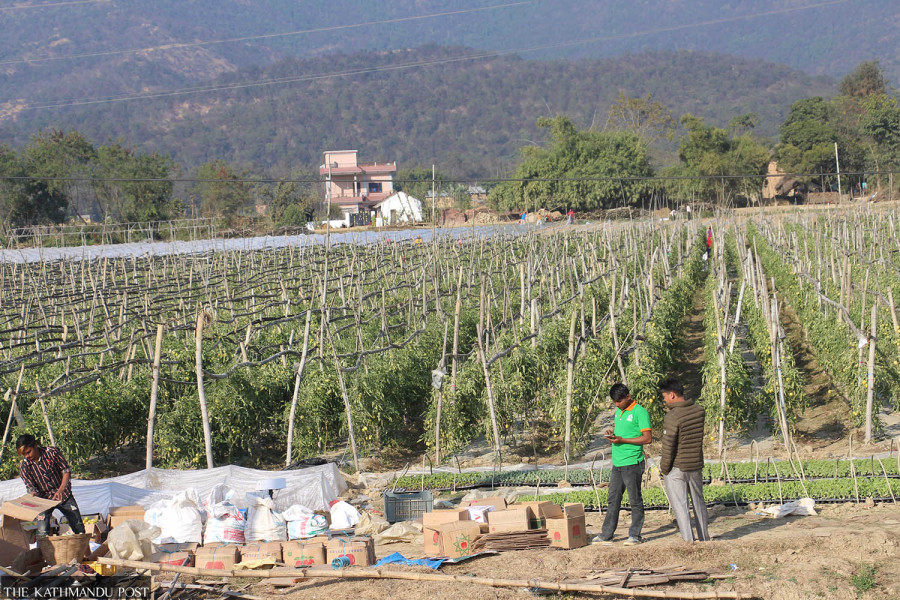Money
Despite regular supply, prices of vegetables in Kathmandu rise
Due to the rising cost of vegetables, most Nepalis have cut the recommended intake of vegetables from their plate.
Post Report
Despite regular supply, the prices of most vegetables in Kathmandu Valley have gone up sharply, forcing the majority of Nepalis to cut the recommended daily vegetable intake.
Traders said that farmers have increased the rates of vegetables due to the rise in the cost of production.
The comparative price index of the wholesale vegetable market in Kalimati shows that the price of vegetables like tomatoes, potatoes, onions, and other seasonal and non-seasonal vegetables has increased within two weeks.
“The supply situation is normal,” said Binay Shrestha, information officer at the Kalimati Fruits and Vegetable Market Development Board, the country’s largest vegetables and fruits marketplace. “Normally, the vegetable price goes up in the rainy season. This year, farmers have increased the prices of their crops, and as a result, prices have increased sharply.”
He said that farmers’ crops have been hit by excessive rainfall. The heatwave, too, affected production. “To compensate for their losses, vegetable prices increased at the farm gate.”
The Kalimati market received over 700 tonnes of vegetables on Wednesday, which is considered a normal supply.
The wholesale price of all three different types of tomatoes has increased.
The price of tomato big (Nepali) has increased by 26.67 percent to Rs95 per kg, while the price of tomato small (local) has jumped by 101.52 percent to Rs45 per kg, and the price of tomato small (tunnel) has gone up by 92.13 percent to Rs61 per kg.
The potato price has also increased significantly. The price of potato red (Indian) has increased by 3.64 percent to Rs57 per kg, potato red (Mudhe) has gone up by 15.69 percent to Rs59 per kg, and potato white has risen by 4.57 percent to Rs53.33 per kg.
The dry onion price increased by 18.63 percent to Rs97.67 per kg.
Shrestha said the onion price has been impacted by the rise in the Indian onion price.
The wholesale price of cabbage (local) has jumped by 30.05 percent to Rs75 per kg within two weeks. The wholesale price of cauli local (Jyapu) has also risen by 15.79 percent to Rs110 per kg.
On Thursday, the Cowpea (long) price increased by 26.67 percent to Rs95 per kg.
The price of bottle gourd has increased by 28.57 percent to Rs45 per kg and smooth gourd by 28.57 percent to Rs45 per kg.
Despite being seasonal vegetables, the price of pointed gourds has increased. The wholesale price is Rs75 per kg, up 36.36 percent.
Similarly, the price of French beans (local) increased by 46.15 percent to Rs95 per kg, while the price of French beans (hybrid) also increased by 46.15 percent to Rs95 per kg within two weeks.
The wholesale price of sword beans climbed by 4.55 percent to Rs115 per kg.
The prices of squash (round) and okra have also gone up. The squash round price has gone up 30.77 percent to Rs85 per kg, and the okra price has gone up 28.57 percent to Rs45 per kg.
According to Nepal Rastra Bank, vegetable inflation increased by 16.02 percent in mid-June compared to the same period last year.
A separate report said that Nepalis are consuming fewer vegetables and fruits due to cost factors and their growing habit of consuming packaged foods.
According to Global Food Policy Report 2024, published by the International Food Policy Research Institute last month, in Nepal’s capital, Kathmandu, children under two years get a quarter of their calories from unhealthy snack foods and beverages.
The report said that only 1.1 percent of Nepalis adults (over 15 years old) consume 400 grams of fruits and vegetables daily, which is the WHO's recommendation.
The report showed that Nepal’s consumption of salty and fried snacks is high among South Asian nations, with more than 40 percent of the population eating them.
Fruits and vegetables are rich sources of vitamins, minerals, fibre, and antioxidants that protect against numerous diseases.
The report said that in 2050, no countries in sub-Saharan Africa and few countries in Asia and the Pacific could supply the World Health Organization’s minimum recommended daily per capita intake of 400 grams of fruits and vegetables.
The cost premium—that is, the additional cost for the least-cost nutrient-adequate diet above the least-cost source of calorie adequacy—is larger in South Asia than in any other region.
For example, dark green leafy vegetables and vitamin A-rich fruits and vegetables cost 8 to 22 times more per calorie than starchy staples and twice as much per calorie as sugary and salty snacks.
A study in a low-income country revealed substantial changes in food behaviours over the past decade, with increased consumption of rice, meat, and highly processed snack foods.




 7.12°C Kathmandu
7.12°C Kathmandu












%20(1).jpg&w=300&height=200)
